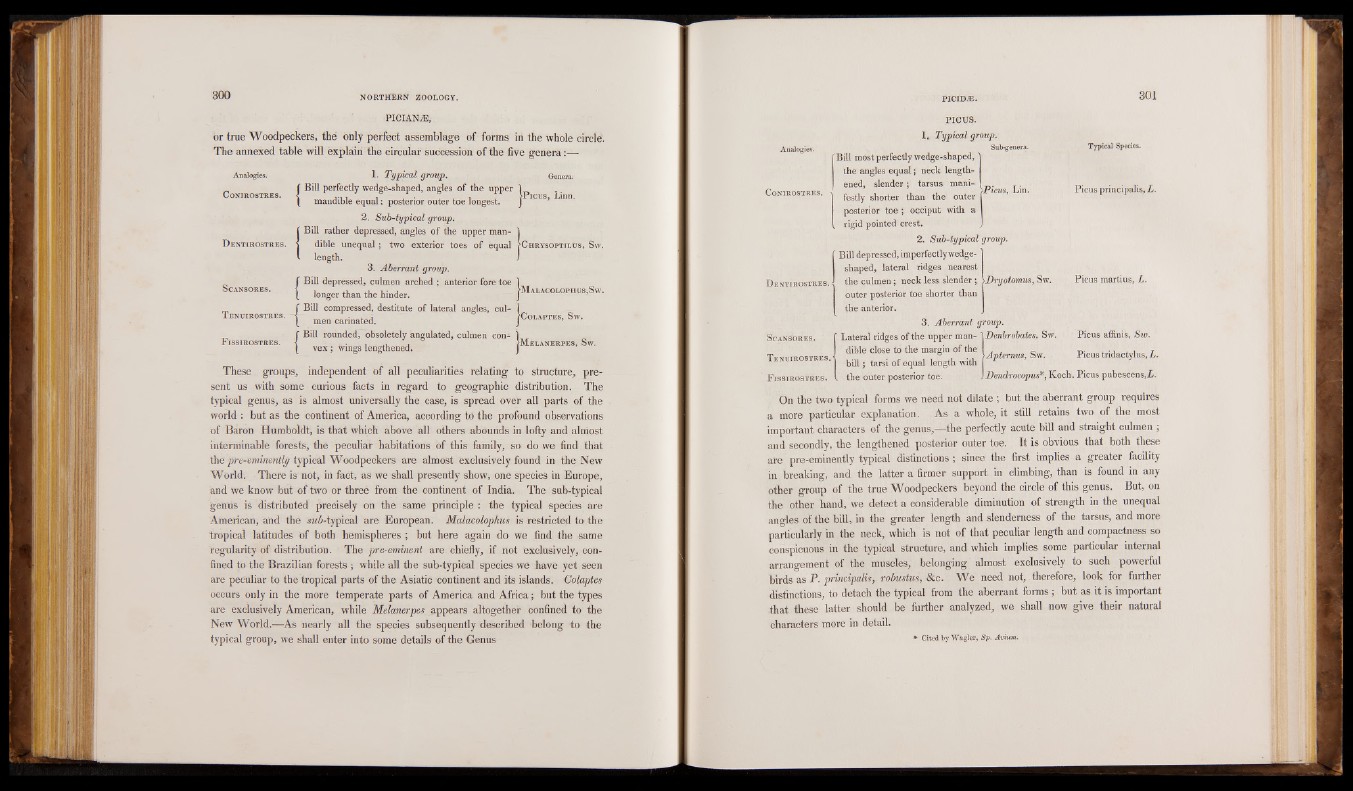
FICIAtLE,
or true Woodpeckers, thé only perfect assemblage of forms in the whole circle'.
The annexed table will explain the circular succession of the five genera:—
Analogies.
CONIROSTRES.
Dentirostres.
SCANSORES.
Tenuirostres.
Fissirostres.
1. Typical group. Genera:
Bill perfectly wedge-shaped, angles of the upper
mandible equal; posterior outer toe longest.
2. Sub-typical group;
{ Bill rather depressed, angles of the upper mandible
jpicus, Linn.
unequal; two exterior toes of equal pChrysoptilus, Sw.
length. J 3. Aberrant group.
Bill depressed, culmen arched ; anterior fore toe 1
longer than the hinder. JMalacoloph^ S w.
Bill compressed, destitute of lateral angles, cul- I __ men cannatVeid . J( CoLAPTE.S ,’ Sw.
Bill rounded, obsoletely angulated, culmen con-1 1 vex; wings ,l eng,t,h ened, . IM e l a n e r pe s, Sw.
These groups, independent of all peculiarities relating to structure, present
us with some curious facts in regard to geographic distribution. The
typical genus, as is almost universally the ease, is spread over all parts of the
world : but as the continent of America, according trt the profound observations
of Baron Humboldt, is that which above all others abounds in lofty and almost
interminable forests, the peculiar habitations of this family, so do we find that
the pre-eminently typical Woodpeckers are almost exclusively found in the New
World. There is not, in fact, as we shall presently show, one species in Europe,
and We know but of two or three from the continent of India. The sub-typical
genus is distributed precisely on the same principle : the typical species are
American, and the x?//>-typical are European. Malacolophus is restricted to the
tropical latitudes of both hemispheres ; but here again do we find the same
regularity of distribution. The pre-eminent are chiefly, if not exclusively, confined
to the Brazilian forests ; while all the sub-typical species we have yet seen
are peculiar to the tropical parts of the Asiatic continent and its islands. Oolaptes occurs only in the more temperate parts of America and Africa; but the types
are exclusively American, while Melanerpes ^appears altogether confined to the
New World.“ As nearly all the species subsequently described belong to the
typical group, we shall enter into some details of the Genus
CONIROSTRES.
Dentirostres.
Sc an sores.
Tenuirostres.
F issirostres.
Picus, Lin.
PICUS.
1, Typical group. Sub-genera. Bill most perfectly wedge-shaped, ‘
the angles equal; tteck lengthened,
slender ; tarsus manifestly
shorter than the outer
posterior toe ; occiput with a
rigid pointed crest.
2. Sub-typical group.
Bill depressed, imperfectly wedge-
shaped, lateral ridges nearest
the culmen; neck less slender ;
outer posterior toe shorter than
the anterior.
3. Aberrant group.
( Lateral ridges of the upper man- 'JDenbrobates, Sw.
dible close to the margin of the ^
bill; tarsi of equal length with
fApternus, Sw.
the outer posterior toe.
Typical Species.
Picus principalis, L.
Dryotomus, Sw. Picus martius, L.
Picus affinis, Sw.
Picus tridactylus, L.
) Dendrocopus*,Koch. Picus pubescens,L.
On the two typical forms we need not dilate ; but the aberrant group requires
a more particular explanation. As a whole, it still retains two of the most
important characters of the genus,—the perfectly acute bill and straight culmen ;
and secondly, the lengthened posterior outer toe. It is obvious that both these
are pre-eminently typical distinctions ; since the first implies a greater facility
in breaking, and the latter a firmer support in climbing, than is found in any
other group of the true Woodpeckers beyond the circle of this genus. But, on
the other hand, we detect a considerable diminution of strength in the unequal
angles of the bill, in the greater length and slenderness of the tarsus, and more
particularly in the neck, which is not of that peculiar length and compactness so
conspicuous in the typical structure, and which implies some particular internal
arrangement of the muscles, belonging almost exclusively to such powerful
birds as P. principalis, robustus, &c. We need not, therefore, look for further
distinctions, to detach the typical from the aberrant forms ; but as it is important
that these latter should be further analyzed, we shall now give their natural
characters more in detail. * Cited by Wagler, S p . A v iu m .